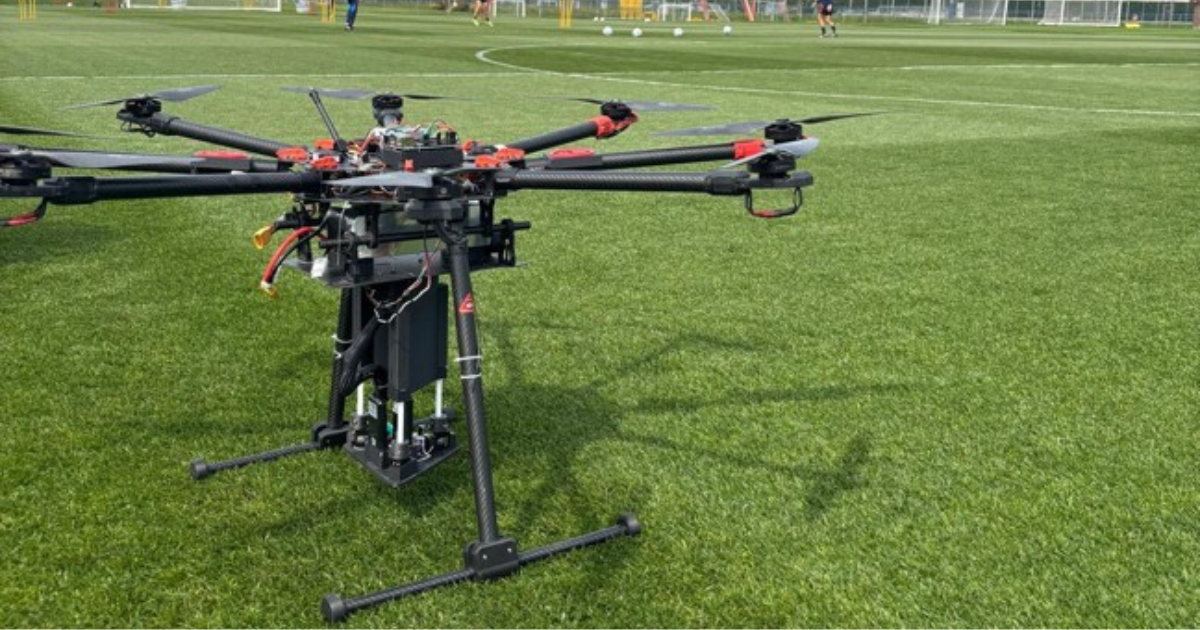
Space11: “In modern football, turning the pitch into a source of strategic data means having a real competitive advantage”
In the era of data-driven football, performance analysis is no longer limited to athletes’ GPS data. The next frontier of innovation concerns the fundamental infrastructure on which all matches take place: the turf. Its quality directly influences player health, athletic performance, and the club’s economic efficiency.
SFS25 is pleased to present Space11, a pioneer in deep-tech solutions that is revolutionizing the management of sports fields.
To understand the scope of this innovation, we spoke with Raffaele Simonetta, CEO & Founder of Space 11 S.R.L., who guided us through the operation of SportIA, their patented system that uses heavy-duty drones, multi-sensor modules, and Artificial Intelligence to create a true dynamic Digital Twin of the playing surface. This is not just a maintenance tool; it is a predictive platform that transforms field management from a reactive and subjective process into a scientific, targeted, and sustainable action.
You will discover how Space11 not only promises to reduce water and fertilizer waste by up to 30% but also to provide technical and medical staff with objective data for injury prevention, making the pitch an active and strategic element of competitive success.
Space 11 specializes in deep-tech solutions such as the Digital Twin. Could you explain what your SportIA system consists of and how the integration of satellite data, drones, and AI allows you to create a “digital twin” of a football pitch’s turf?
“SportIA is the heart of our ecosystem: an intelligent and completely autonomous monitoring system, designed to transform every football pitch into a self-diagnostic environment. At the center of this architecture is our patented multi-sensor module, a single compact and advanced device that integrates agronomic sensors, a torsiometer, cameras, and high-definition video cameras. This module, mounted on a heavy-duty drone, allows for the collection of in-depth biomechanical and agronomic data — such as humidity, soil torsion, pH, temperature, compaction, and reflectance — with unprecedented precision.
Thanks to processing via cloud-based artificial intelligence, this data is transformed into a dynamic Digital Twin of the pitch: an always up-to-date digital copy, capable of providing a detailed and predictive map of the turf’s condition, zone by zone, in real-time. Integration with satellite data and weather forecasts further amplifies the model’s accuracy, offering clubs a 360° view, both for predictive maintenance and optimization of sports performance“.
Traditionally, pitch management is reactive. What are the key benefits, in terms of predictive maintenance and resource optimization, that your solution offers to Ground Managers of Serie A clubs or other categories? How does AI reduce costs and improve pitch quality?
“Traditionally, sports pitch maintenance is reactive, manual, and scattered: intervention only occurs when the problem is already visible, often relying on subjective assessments or stand-alone tools. This approach inevitably leads to waste of resources, untargeted interventions, and a pitch that varies too much in quality and safety. With our SportIA platform, we completely change the paradigm. Thanks to the creation of an always-updated Digital Twin, Ground Managers have access to a predictive and interactive map that shows, at all times, where to intervene, how, and with what priority. Artificial intelligence processes the data collected by the drone and the multi-sensor module to anticipate critical issues, flag areas at risk of compaction or water stress, and generate automated operational recommendations. It is no longer management based on feeling, but scientific maintenance, supported by objective data..
This translates into concrete benefits:
– Savings of up to 30% on water and fertilizers, thanks to geolocalized intervention
– Reduction of unnecessary labor
– Better pitch performance, with more stable optimal conditions
– Decreased injury risk, thanks to biomechanical ground management”.
The quality of the ground has a direct impact on the performance and health of the players. Can the Digital Twin correlate turf data with performance data (e.g., GPS or injuries) to assist the technical and medical staff? How does the pitch become a strategic and not just a logistical element?
“Ground quality is not just an aesthetic or logistical issue: it is a determining factor for athletic performance and injury prevention. A ground that is too hard, wet, or asymmetrical can alter running biomechanics, increase joint stress, and, over time, generate microtraumas or lesions. With our SportIA system, the pitch is transformed into a strategic asset, no longer just a playing surface, but an active element of the performance process. The Digital Twin we generate allows for:
•Correlating biomechanical turf data (such as hardness, torsion, traction) with players’ GPS, physical, or clinical data
•Identifying risk zones where the ground may contribute to muscle overloads or compensations
•Supporting technical and medical staff in planning training, rotations, or returns to the field based on objective data”.

Environmental sustainability (a crucial theme of SFS 25) requires consumption optimization. To what extent does the real-time analysis of data (e.g., humidity, nutritional needs) allow you to reduce the use of water, fertilizers, or pesticides, helping clubs achieve their ESG objectives?
“Sustainability is no longer an option today; it is a responsibility. Football clubs, especially high-level ones, are called upon to reduce the environmental impact of their infrastructure, and pitch management is one of the most critical sectors in terms of water, fertilizer, and chemical consumption. With the Space 11 system, we enter the era of sustainable and intelligent maintenance. Thanks to real-time multi-sensor monitoring, we are able to:
• Accurately analyze soil humidity, avoiding unnecessary irrigation
• Detect localized nutritional deficiencies, preventing homogeneous and untargeted distribution of fertilizers
• Reduce the use of pesticides and plant protection products, intervening only where necessary
The data is visualized on interactive maps and transformed into targeted actions, with an estimated reduction of up to:
• 30% in water consumption
• 25% n fertilizers
• 40% in unnecessary interventions
These results not only generate economic savings but also help clubs achieve their ESG objectives and concretely communicate their commitment to the environment — a key value for sponsors, fans, and institutional stakeholders“.
Many clubs are investing in advanced tactical analysis, but often neglect infrastructure. Do you believe that Digital Twin technology can represent a real competitive advantage for the teams that adopt it, compared to those who manage the pitch traditionally?
“Many clubs today invest millions in technologies for tactical analysis, individual performance, and athlete recovery. But there is a key element that is often overlooked: the physical infrastructure on which all of this takes place, which is the playing field. Continuing to manage it with fragmented tools or reactive approaches is a competitive limitation. With Space 11’s Digital Twin technology, the pitch moves from being a simple ‘stage’ to becoming a strategic asset, controlled, optimized, and integrated into the club’s decision-making flow. The advantages for those who adopt this vision are tangible:
• Better athlete performance due to ideal soil conditions
• Fewer injuries thanks to personalized biomechanical turf management
• Reduced operating costs and greater sustainability
• Traceable data that feeds technical, medical, and managerial decisions
In modern football, where every detail can make the difference between a win and an injury, turning the pitch into a source of strategic data means having a real, concrete, and replicable competitive advantage. Those who remain tied to traditional management risk being left behind, not only technically but also in terms of attractiveness to sponsors, athletes, and stakeholders”.
What is your strategic goal in participating in the SFS 25? What is the main message that Space 11 wants to convey to clubs and institutional players regarding the future of digital sports infrastructure?
Participating in the Social Football Summit 2025 means bringing a strong message for us: the future of football also passes through the digital transformation of its infrastructure. Today, the pitch is no longer just a physical place, but it can become a continuous source of data, knowledge, and value. With Space 11, we want to demonstrate that it is possible to digitize the playing field, optimize it, make it safer for athletes, and more sustainable for clubs, transforming it into a strategic asset on par with sports performance or video analysis. Our strategic goal at SFS 25 is twofold:
1. To create connections with forward-thinking clubs and federations, ready to innovate even ‘under the feet’ of their athletes.
2. To raise awareness among decision-makers about the importance of integrating predictive and sustainable technologies into pitch management, thereby contributing to ESG objectives and the reduction of operating costs”.



